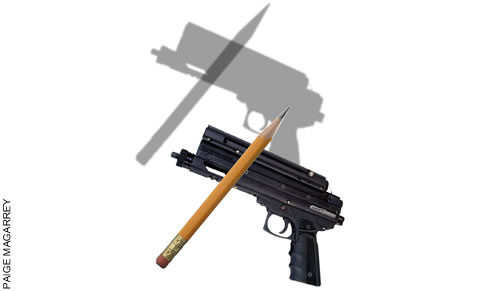 The world’s journalists have a problem, and it’s murder.
The world’s journalists have a problem, and it’s murder.
The international death toll of journalists is reported to be increasing at a staggering rate, according to an extensive report released by the International News Safety Institute (INSI) earlier this month. The INSI, a non-profit coalition of media organizations, press freedom groups, unions and humanitarian campaigners based in Brussels, reported that 168 members of the news media were murdered in 2006 — up from 146 in 2005 and 105 in 2001. The INSI website reports that there have already been 36 murdered this year.
If you’re picturing soldiers and crossfire as you read this, think again. One of the most startling facts in the report is that of the 1,000 journalists murdered in the last 10 years, 731 were killed, not in settings of armed conflict, but in countries at peace. The most dangerous peacetime countries in which to practice the craft are Russia, Colombia, the Philippines and Iran. INSI stats show Russia to be the deadliest of these, with 91 news media members killed in the last 10 years (1996 up to mid-2006) compared to 138 in Iraq, the only country with more murders.
The INSI is not the only organization recognizing this disturbing trend. The Committee to Protect Journalistsand Reporters without Borders both reported that 2006 was a record-breaking year for number of journalists murdered. The actual numbers listed by each organization tend to vary though, depending on whether or not they include journalists who have been reported to have just disappeared, committed suicide or died under mysterious or suspicious circumstances.
In the Reporters without Borders 2006 annual report, Benoit Hervieu, head of the organization’s Americas desk, called Colombia “one of the region’s most dangerous for journalists,” with threats and pressure coming from, among other sources, guerilla groups. “News is a key commodity in Colombia’s civil war, that all sides try to control by monitoring, threatening or even punishing journalists,” wrote Hervieu. The report also targeted the Philippines stating, “President Gloria Arroyo… tried to stop the press from doing its job of safe-guarding democracy.”
Rodney Pinder, director of INSI, says two main factors have caused an increase in the number of murders in peacetime countries. First, journalists are not as likely to be seen as politically neutral or objective. “Years ago, journalists were more separate and were respected as such. Now they are seen as targets,” says Pinder. The second more serious factor is impunity. “Only one in 10 of the murderers of journalists are convicted,” he says. “They see murder as a cheap and easy form of censorship. If they got away with one, what’s stopping them from killing another?” says Pinder. The rising culture of impunity makes it difficult to know who is executing and ordering the killings. It has become such a major issue that UNESCO has chosen impunity as the theme of the upcoming World Press Freedom Day on May 3.
• • •
Edward Lucas, a British journalist, has covered Eastern Europe since 1986, and was the Moscow bureau chief for The Economist for four years. Currently he is the magazine’s central and east European correspondent. He says reporting in Russia is more dangerous now than at any other time during his coverage of the region. “If you offend the wrong people, you may get killed.” And journalism there is riddled with payoffs, he says. “For instance, as a reporter you will write something positive, receive a bribe from it and give some of the money to your editor. This is one of the main businesses in Russian journalism.” But it was not always this bad. Lucas says in the early 1990s until about 1998 Russian secret police (called the KGB until 1991 and following that the FSB), had much less influence and power, which made it easier to report in the region. “In those years, it was easier for journalists to get the mobile numbers of powerful people,” he says.
Being a Western journalist in Russia is less risky than being a local reporter for a small paper, says Lucas. Although no one is completely immune from threats or intimidation, “few Western journalists are ever killed,” he says. “Western journalists are more likely to run into problems with libel suits, or having their sources frozen — no one will talk to you anymore — or not being allowed to enter the country, which is a big problem if you are the Russian correspondent and you can’t get into Russia.” Still, in 2004, Paul Klebnikov, the editor-in-chief of the Russian edition of Forbes magazine was shot as he left his office building in Moscow. “Khlebnikov’s murder showed that even a Western journalist could be murdered, thus raising the risk level for everyone else.” Lucas sees the murders of journalists in Russia as a symptom of complex social and political problems, including economic class issues. “The rich and powerful have become more daring,” he says. “If you’re rich, you’re rich enough to have a journalist killed.” But, he says, drawing international attention to the problem can help.
One of the most prominent recent examples of a Russian journalist being killed was the murder of Anna Politkovskaya, the reporter known for her critical reporting on Russia’s policy in Chechnya. She was gunned down in her apartment building in Moscow. The INSI report states that most of the journalists murdered in peacetime countries, listing specifically Mexico, the Philippines and Russia, have “typically been working on stories about corruption, drug trafficking and other criminal affairs.”
The Politkovskaya case got a lot of attention from NGOs and Western media, including a feature story in this year’s January 29 issue of The New Yorker. Canadian Journalists for Free Expression (CJFE) and 10 other media watch-dog groups wrote to President Vladimir Putin asking him for “an independent and thorough investigation.” Julie Payne, the manager of CJFE, says that they have not yet received a reply from the Russians. “The mail must be terribly slow,” she laughs.
Payne says one of the reactions by major news organizations to protect their journalists, especially in war zones, is the recent trend of embedding. “They are doing this as a move to keep journalists safer,” she says, “but most [of the journalists murdered] are local journalists, who are without protection.”
Samantha Topping, a representative of Reuters — one of the world’s foremost media organizations, which has lost five journalists in the current Iraq war — says, “Obviously, the problem is on our radar.” But she declined to describe the agency’s security measures to protect its journalists.
The INSI report calls for international groups, national governments, military groups, news organizations and other journalists to respond to the problem by condemning the attacks and informing journalists more clearly about the dangers in specific countries. It also recommends training journalists how to better protect themselves. One recent step forward: a United Nations Security Council resolution condemns attacks on journalists. It may turn out to be “all shout and little action,” says Pinder, “but it’s a small step in ratcheting up the pressure.”
Still, he says, “There is not much improvement anywhere, and it will take a long time before things get better.”
About the author
David Pratt was the Associate Editor for the Spring 2007 issue of the Ryerson Review of Journalism.

